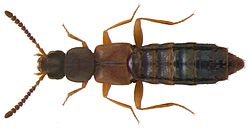| Dinaraea aequata | |
|---|---|
 | |
| Scientific classification | |
| Kingdom: | Animalia |
| Phylum: | Arthropoda |
| Class: | Insecta |
| Order: | Coleoptera |
| Suborder: | Polyphaga |
| Infraorder: | Staphyliniformia |
| Family: | Staphylinidae |
| Genus: | Dinaraea |
| Species: | D. aequata |
| Binomial name | |
| Dinaraea aequata | |
Dinaraea aequata is a species of rove beetle native to Europe. [2] [3]